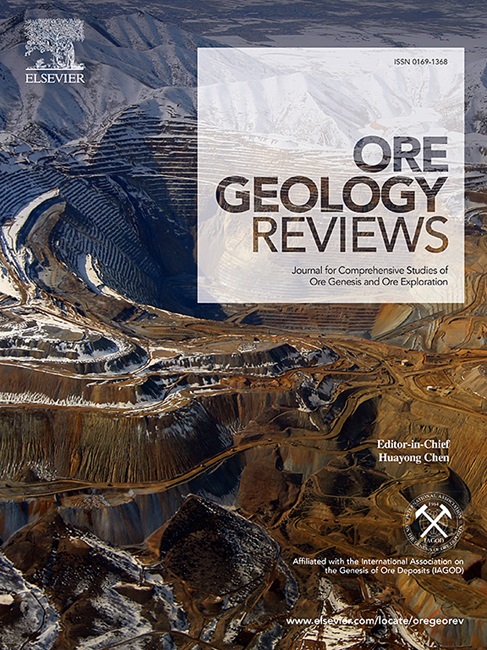Genesis of the Ganfang Li-Rb-Cs-Be-Ta-Sn rare metal deposit: Evidence from geochemistry, geochronology, and Nd isotopes
IF 3.2
2区 地球科学
Q1 GEOLOGY
引用次数: 0
Abstract
Rare metal deposits are generally associated with highly fractionated granites with unique geochemical signatures and the mineralization is controlled by composition of magmas, degree of magma fractionation, and magmatic-hydrothermal processes. The Ganfang rare metal deposit, located in Jiangxi Province, south China, is hosted within a strongly peraluminous, P and F-rich S-type rare-metal granite pluton (the Ganfang composite granite pluton) of Early Cretaceous age in the Jiuling Neoproterozoic granitic batholith. The pluton comprises two-mica monzogranite, topaz-bearing muscovite-albite granite, and felsite (locally aplitic) dikes. The topaz-bearing muscovite-albite granite is highly enriched in Li, Ta, Sn, Nb, Be, Rb, and Cs, while the felsite displays ultra-high enrichment of P, Li, Cs, Rb, Be, W, Sn, Nb, and Ta. The cassiterite U–Pb (137–140 Ma), monazite U–Pb (∼140 Ma), and muscovite Ar–Ar (140–142 Ma) ages indicate a coeval magmatic association for the pluton. Nd isotopic compositions indicate magmatic origination in the Late Paleoproterozoic metasedimentary basement. However, the significant differences in contents of SiO2, Al2O3, Li2O, P2O5, Rb2O, Cs2O, and F among these three components suggest unlikely a single parental magma source. The columbite minerals in the topaz-bearing muscovite-albite granite show complex replacement textures and unique chemical composition, suggesting involvement of locally Ta-saturated magma and melt-fluid metasomatism during the magma evolution process. The felsite shows high F (up to 1 wt%), P2O5 (up to 1.2 wt%), and Li2O (up to 1.5 wt%), indicating that the magma sequestered a large quantity of incompatible elements and ascended rapidly through the melt column to its emplacement level. In summary, enrichment of source magmas with rare metals, extreme fractionation, and melt-fluid metasomatism are the key factors in controlling genesis of the Ganfang Li-Rb-Cs-Be-Ta-Sn deposit.

甘方Li-Rb-Cs-Be-Ta-Sn稀有金属矿床成因:地球化学、年代学和Nd同位素证据
稀有金属矿床一般与具有独特地球化学特征的高分选花岗岩伴生,成矿作用受岩浆组成、岩浆分选程度和岩浆-热液作用控制。江西赣坊稀有金属矿床赋存于九岭新元古代花岗岩基中早白垩世强过铝、富P、富f的s型稀有金属花岗岩岩体(赣坊复合花岗岩岩体)中。该岩体由二云母二长花岗岩、含黄玉的白云母-钠长石花岗岩和长石(局部粘质)岩脉组成。含黄玉的白云母-钠长石花岗岩高度富集Li、Ta、Sn、Nb、Be、Rb、Cs,而辉石超富集P、Li、Cs、Rb、Be、W、Sn、Nb、Ta。锡石U-Pb (137 ~ 140 Ma)、独居石U-Pb (~ 140 Ma)和白云母Ar-Ar (140 ~ 142 Ma)年龄表明该岩体具有同时期岩浆关联。Nd同位素组成表明岩浆成因为晚古元古代变质沉积基底。然而,SiO2、Al2O3、Li2O、P2O5、Rb2O、Cs2O和F的含量差异显著,表明岩浆源不可能是单一的。含黄玉的白云母-钠长石花岗岩中柱长石矿物具有复杂的替代结构和独特的化学成分,表明岩浆演化过程中存在局部饱和ta岩浆和熔融流体交代作用。felsite显示高F(高达1 wt%), P2O5(高达1.2 wt%)和Li2O(高达1.5 wt%),表明岩浆隔离了大量不相容元素,并通过熔体柱迅速上升到其就位水平。综上所述,源岩浆富集稀有金属、极端分选作用和熔融流体交代作用是控制赣方Li-Rb-Cs-Be-Ta-Sn矿床成因的关键因素。
本文章由计算机程序翻译,如有差异,请以英文原文为准。
求助全文
约1分钟内获得全文
求助全文
来源期刊

Ore Geology Reviews
地学-地质学
CiteScore
6.50
自引率
27.30%
发文量
546
审稿时长
22.9 weeks
期刊介绍:
Ore Geology Reviews aims to familiarize all earth scientists with recent advances in a number of interconnected disciplines related to the study of, and search for, ore deposits. The reviews range from brief to longer contributions, but the journal preferentially publishes manuscripts that fill the niche between the commonly shorter journal articles and the comprehensive book coverages, and thus has a special appeal to many authors and readers.
 求助内容:
求助内容: 应助结果提醒方式:
应助结果提醒方式:


